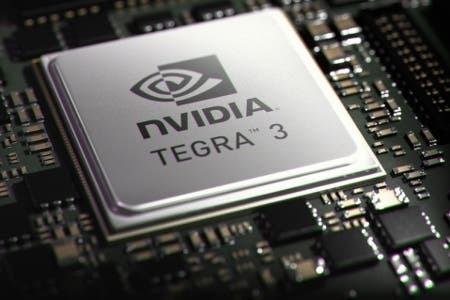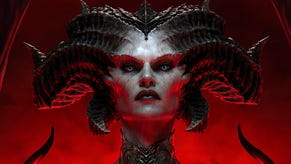Tech Analysis: How Powerful is Tegra 3?
Digital Foundry dissects the processor inside Ouya, Nexus 7 and the latest Transformer tablets.
NVIDIA has its sights set on dominating mobile gaming: the ubiquitous Tegra 3 chipset powers the Google Nexus 7 and Microsoft's upcoming Surface tablet, with the same technology taking centre-stage in the controversial Ouya micro-console set for release in March next year. Bold claims are being made for the capabilities of the quad-core processor - particularly from the Ouya camp - so we decided to source a range of Tegra-powered hardware available right now and see how it copes with some of the most challenging Android games on the market.
The term "console quality" is bandied about all-too frequently, but just how close do the best Tegra games get to the current HD generation? How good is the £159 Nexus 7 tablet as a games machine, and in the case of Ouya, just what should be expect from the "intense graphics" the manufacturer is claiming the unit is capable of producing?
We tested out three different Tegra-based products - the Google Nexus 7, the Transformer Pad TF300 and the Transformer Prime. The Nexus 7 and the TF300 run many games very similarly indeed - not surprising bearing in mind that they use the exact same Tegra T30L chipset, clocked at 1.2GHz with a 416MHz GeForce GPU component. The Transformer Prime offers us a little extra grunt, with the quad-core A9s clocked at 1.4GHz and a useful GPU boost to 520MHz - however, it uses the same DDR2 RAM as the Nexus 7, rather than the more bandwidth-happy DDR3 in the TF300. So what we have here are three different Tegra 3 configs that should give us some idea of how the range scales, and in comparing the Prime against the TF300 we should see how faster memory could perhaps mitigate slower clocks.
In theory, analysing the outputs of the Transformers with the existing Digital Foundry tools should be no problem whatsoever, because HDMI mirroring is enabled on both devices, meaning that frame-rate testing with our usual capture equipment is a viable option.
Why a Tegra Tablet with HDMI Output Won't Match Ouya
That's the theory, at least, but the reality is somewhat different, because anyone saying that HDMI-equipped tablets are viable for HDTV gaming, or an approximate representation of what the forthcoming Ouya offers, needs to take another look at the performance level on the more demanding 3D games.
Unlike a PC graphics card, cloning the framebuffer to two different screens produces an eye-opening drop in the performance level, depending on the game - which we assume is down to the increased bandwidth requirement of servicing twin displays. That being the case, traditional Digital Foundry frame-rate analysis only tells us how good - or how bad - HDMI output performance is, and doesn't give us any kind of feeling for Tegra 3's capabilities overall. Come March next year, however, Ouya is ripe for testing in the conventional manner - after all, its entire horsepower will be dedicated to serving just the single video output.
"HDMI output on demanding titles causes noticeable frame-rate drops compared to running from the tablet screen: servicing two displays appears to present mobile tech with serious bandwidth challenges."
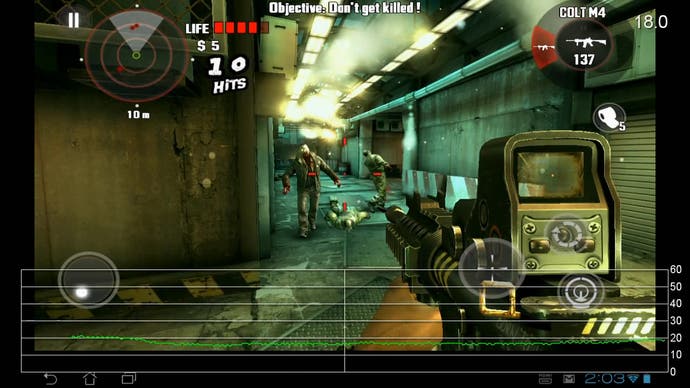


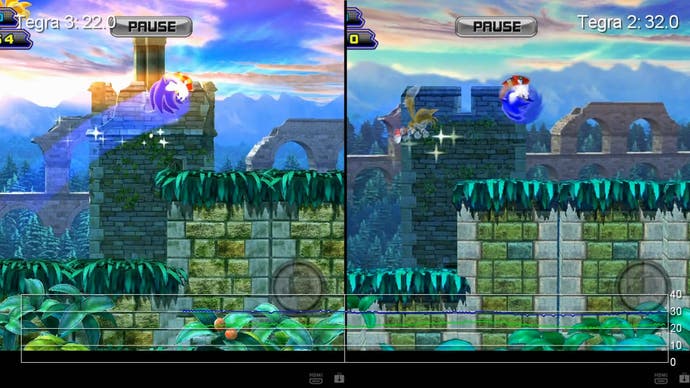
This is not to say that analysing the performance of Tegra 3 tablets is impossible with HDMI off the table - it just becomes a lot more difficult. We can point a high-speed camera at the screen and record it at 60 frames per second and, by manually counting frames, we get some idea of the overall performance level - and by extension we can also see just how much HDMI mirroring can hit frame-rate. Grand Theft Auto 3, for example, regularly hits 15 frames per second on HDMI output, when the tablet screen is running at twice the frame-rate - or faster - once decoupled from the display. Dead Trigger can also hit a low of 15FPS on HDMI displays, even though it actually spends much of the time running north of 30FPS, even occasionally hitting 60FPS in places when running on the tablet screen alone.
It's also worth mentioning that Tegra 3 tablets are not alone here when it comes to the inadequacies of HDMI output: both iPad 2 and new iPad cannot produce HDMI mirroring that accurately matches the screen update. Indeed, in the case of iPad 2, HDMI output has actually degraded badly across the board in our tests since the advent of iOS 5 - even when the main tablet screen isn't being mirrored. We once tested Real Racing HD back in the iOS 4 days and measured a 1080p30 update via HDMI - now, on the same iPad running the same game under iOS 5, it's closer to 15FPS. Ouch.
Tegra Enhanced Games: How Are They Improved?
Still, these are mobile games machines and they should be judged as such. Kicking off, we take an opening look at two titles which demonstrate NVIDIA's focus on producing unique mobile experiences. Both Sonic 4 Episode 2 and Shadowgun are presented on NVIDIA's TegraZone store in two different versions - a standard edition of each game designed to work on older Tegra GPUs along with "THG" enhanced versions built to take advantage of the additional horsepower available in Tegra 3-enabled devices.
"Tegra 3 can't match the sheer processing power of the top-end PowerVR chips found in the iPad, so instead NVIDIA has gone for customised versions of the top games, with exclusive graphical features."

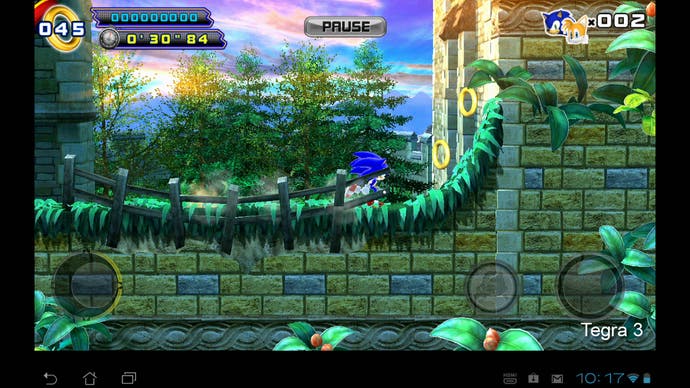

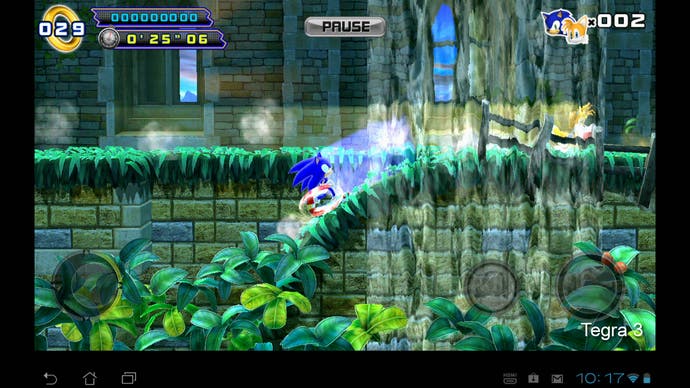
The standard version of Sonic 4 Episode 2 that is available across both Android and iOS services does a pretty decent job of emulating its console counterpart; the gameplay is naturally a match and visually all of the core details have been transplanted across, although the bulk of the artwork has been simplified in order to work across a varied range of smartphones and tablets. Despite there being a few dips in performance in areas with more complex scenery, the Nexus 7 and TF300 have no problems regularly hitting the target 30FPS update when running the game without too many dips in performance, and as a result the game feels relatively responsive to play.
Booting up the Tegra 3-enhanced (THG) version immediately brings with it some eye-opening differences, to the point where the game comfortably holds up against the XBLA and PSN equivalents running on far more powerful hardware. The missing lighting on the iOS and standard Android versions of the game has been reinstated, with neat little touches such as lens flare beaming through the scenery. Geometry detail across the environments is noticeably ramped up, too, with the 2D leaves found in the standard mobile game replaced with textured polygons. Higher-resolution textures are also in play, and there are a number of additional surface shaders in use to enhance water effects, which are also visibly normal mapped, adding yet more depth and detail to various scenes.
It's impressive to see just how many of the console-specific features have been transplanted to this version of the game. That said, the extra workload doesn't come cheap and has a noticeable effect on the game's performance, with far more in the way of intrusive frame-rate drops and a level of smoothness that rarely hits the targeted 30FPS at all. It's mostly around the 22-25FPS mark with rare bursts that return the game to its 30FPS goal. As such, in terms of playability it's hard to recommend the THG edition of the game over the standard release with the Nexus 7 - but it sure looks prettier.
Checking out Sonic on the Transformer Prime, we still see lots of stutter and, while average frame-rates are higher, when the screen fills with transparent alpha effects then performance drops to the same level we see with the TF300. Control feels more responsive in the slower sections of the game on the Prime, and the game is slightly more playable as a result.
"When it comes to rendering tech, there's no such thing as a free lunch. Tegra 3 enhancements can look striking, but game frame-rates are lower compared to the vanilla versions of the same game."
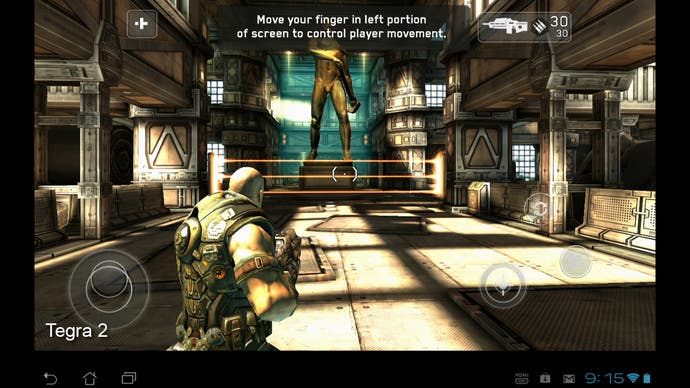
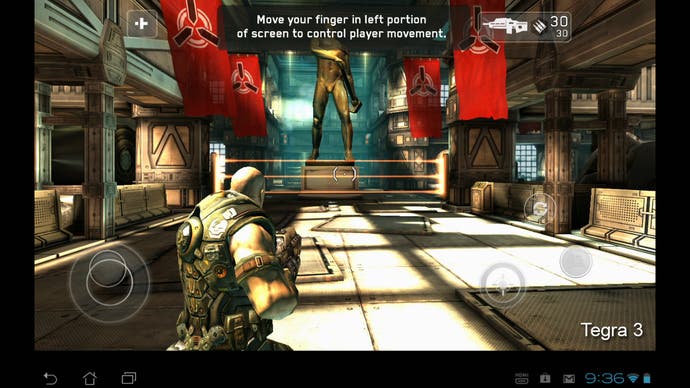
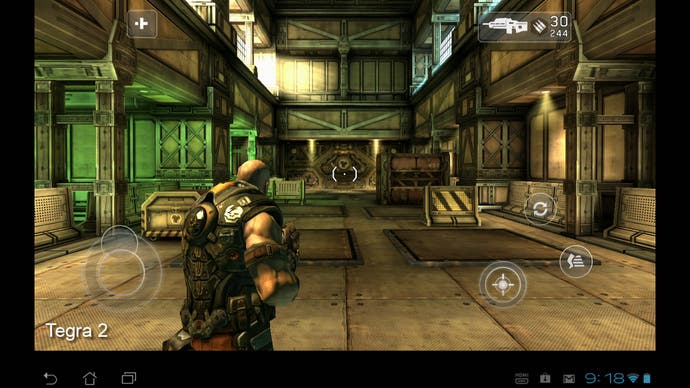
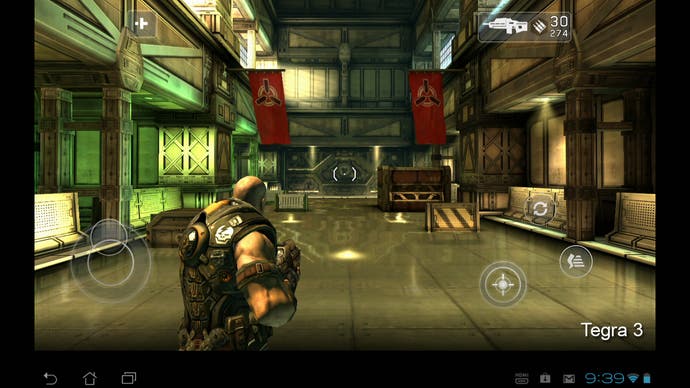
A cover shooter clearly inspired by Gears of War, Shadowgun is a competent third-person title that aptly proves that 'proper' games can - and do - work on touch-screen devices. This fully-fledged approach also travels down to the core graphical make-up of the game. While the art design itself is rather generic, a lot of time has been poured into creating detailed environments and filling these with a range of effects. Indeed, the basic look of the game largely mirrors that of an original Xbox release, spruced up with higher resolution and DX9-era effects work. Environment detail is excellent for a mobile title, with lots of nice graphical touches, such as specular and diffuse reflections on shiny surfaces, and pre-baked lighting which fills the environments with shadow without the additional cost of doing this in real-time.
These features are taken one step further in the THG version of the game. The lighting model is enhanced with better dynamic range (transitions between light and dark areas) and is complemented by the use of bloom, although this can be a bit too strong at times. The environments also feature a number of other additions - such as flags hanging off of the walls - which show off some of the Tegra-exclusive cloth physics. Furthermore, the floor in some sections is covered with a thin layer of water that reacts both to gunshots and your character as you wade through it. The water surface is also reflective (featuring environmental reflections only), and these reflections become distorted as ripples in the water are created and bounce off of surrounding objects.
These extras do require GPU resources, however, and there are times when performance suffers as a result. The initial 30FPS update is easily disrupted on the Nexus 7 when there are multiple enemies on screen, and at this point the additional lag - in combination with reduced precision of using a touch-screen over a controller - begins to negatively impact on the gameplay. Despite these shortcomings, Shadowgun is eminently more playable than Sonic 4 Episode 2 in its THG guise, but once again the Tegra 3 version's bonus goodies come with a tangible impact to frame-rate.
Elsewhere, the Nexus 7 and TF300 make a good fist of rendering graphically demanding games at relatively high - if very inconsistent - frame-rates, managing to preserve playability even if the overall experience isn't quite as polished as it would be running on higher-end Android or Apple devices. The Transformer Prime copes a little better in similar situations with the game slowing down for shorter periods. The engine tends to recover a little more quickly as foes are being gunned down and controller feedback feels a little faster as a result. It's not a dramatic difference, but the extra smoothness on the higher-spec tablet is beneficial.
NOVA 3, Riptide GP, Dead Trigger and Grand Theft Auto 3
Beyond the titles specifically enhanced for Tegra 3, there are a number of games available on both iOS and Android that we were curious to try out and compare. Grand Theft Auto 3 has an options menu that allows you to tweak resolution and detail levels (missing in the iOS version), while Riptide GP has some bonus Tegra effects unseen on iOS. It's also one of the few games to feature a slider that lets you go for frame-rate over resolution. We also gave NOVA 3 a shot, as it's a title that implements a lot of visual effects, and in its top-end iteration incorporates a lot of post-processing technologies including depth of field and motion blur.
"The lack of a fixed hardware platform on Android sees games running with unlocked frame-rates, often with vast shifts in performance at any given moment. The consistency of console just isn't there right now."



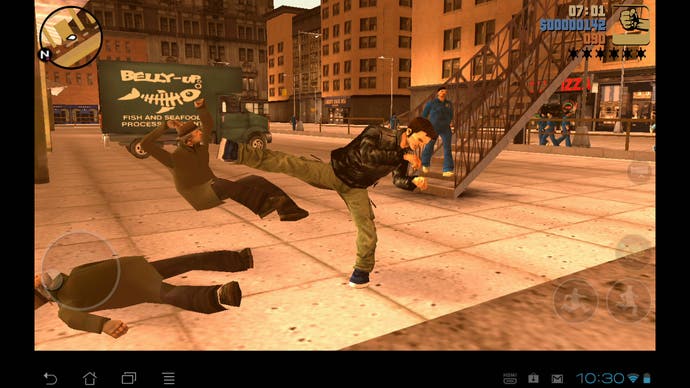
Running GTA3 at full-spec can cause some frequent frame-rate and juddering problems on the Nexus 7, but by dialling down these graphical settings we were able reduce this significantly. While a consistent 30FPS update is still off the cards, we were able to get a noticeable performance boost allowing for smoother gameplay with more responsive controls.
On the other hand, there's a real sense that NOVA 3's lofty aspirations to deliver a low-budget Crysis 2 clone to mobile hardware is just a little too much for the Nexus 7 to handle. Performance is truly awful during fire-fights and when there multiple enemies on screen to the point where the game is barely playable, if at all - we're looking at a consistent sub-20FPS, which commonly drops to 15FPS and sometimes even lower in heated encounters. NVIDIA tells us it is working with GameLoft to better optimise NOVA 3 for the Tegra hardware but as it stands right now it's nowhere near as good as same game running on iPad 2. Indeed, despite losing some effects such as depth of field, the new iPad version runs at retina resolution and still operates at a far smoother frame-rate than the same game running on the Nexus 7. Also disappointing is that the Android version loses all the extra effects work we see on the iPad 2 version.
Conversely, Dead Trigger is plenty of fun, featuring water simulation and ragdoll physics exclusive to Tegra 3. The environments also benefit from smoke bellowing from pipes situated in the walls, and the lighting model is enhanced by use of lens flare and bloom, adding to the liberal use of shadows that bring depth to various scenes. The closed environments, which see you shuffled down linear paths (only branching out upon reach certain sections), also allows for some intricately detailed scenery going beyond the visual scope of many original Xbox titles. Character modelling is fairly accomplished too: low polygon counts are carefully disguised using normal maps, and use of additional shader effects further help to enhance the look of the undead.
Interestingly, while performance is somewhat mixed on the TF300, the game runs with an unlocked frame-rate, with top-end smoothness capped at 60FPS, and with extended drops down to around half of that when the engine becomes stressed. We usually see a middle point between the two, with the tendency to favour the lower end of these metrics when there are multiple enemies on screen. The Prime holds up performance to a better degree, but not to the level we would expect from a 25 per cent GPU clock speed boost. In certain titles, there's a sense that the DDR2 memory is an issue in getting the maximum performance from the processor.
"Titles like Riptide GP and NOVA 3 suggest that the iPad 2 and its successor have the GPU power to run these games with fewer compromises to overall levels of performance."
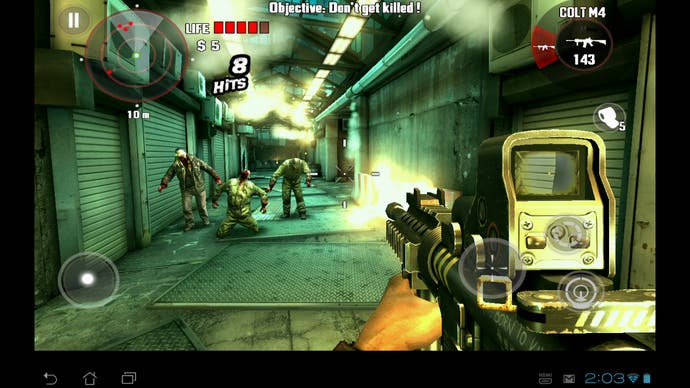
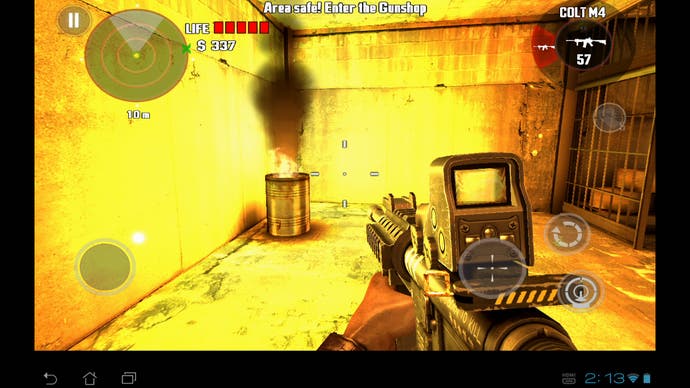

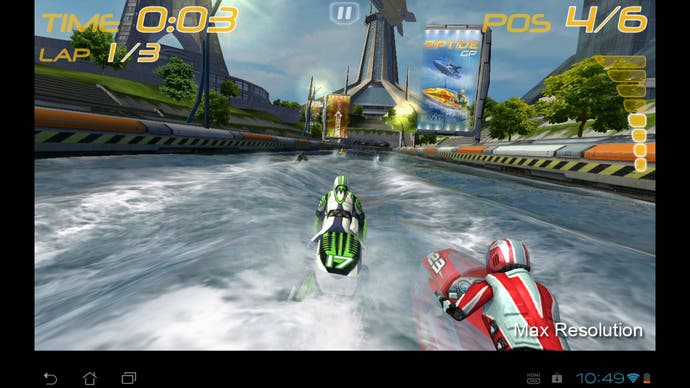
Riptide GP stands out as an intriguing title, due to both the game's lovely use of realistic water effects and physics and the smooth 60FPS update that eludes most of the other visually taxing titles we tried out on the Tegra hardware. The effects of the player's craft reacting with the waves, and in turn affecting the handling model, is particularly impressive. Additionally, NVIDIA's Tegra GPU is put to good use in rendering convincing water effects, with surface reflections and use of normal mapping helping to add a little extra realism. Splashes of water also collide with the camera, running down the screen in a pleasing manner - an effect you don't see on any other version of the game.
However, on the TF300 and Nexus 7, racing through open environments or speeding through large splashes of water can bring about dips in performance, but it's very rare to see the game go below the 40FPS mark. The effect is very similar to the Call of Duty titles, where small drops in frame-rate can often go by unnoticed - the "perceptual 60FPS" effect. However, achieving this performance level comes at a cost - Riptide GP is running at a sub-native resolution by default. It can be adjusted to native 1280x800 resolution but frame-rate drops down closer to 30FPS as a consequence. Our tests with the Transformer Prime show that the higher-clocked Tegra 3 chip manages to cope slightly better when under load (especially when maximum resolution is enabled) squeezing out a little bit more smoothness when the frame-rate is in flux, although the highs and lows are still very similar.
Riptide GP may not be quite so pretty on the iPad 2, but it's running at 1024x768 at what looks like a locked 60 frames per second. The retina-equipped new iPad seems to run the same game at max res with a very similar performance level to what we see on the TF300 and Nexus 7 - a striking example of just how much Apple has invested in market-leading graphics tech - the 45nm A5X die at 163mm2 occupies around twice the area of the Tegra 3 at 40nm.
In Theory: Can Tegra 3 Power an HD Console?
In the final analysis, Tegra 3 acquits itself well as a mobile gaming platform in the here and now, but in the wake of our findings here, questions need to be asked about its suitability as the centrepiece for a 2013 games console.
In like-for-like tests against the iPad 2 and iPad 3, there is a clear performance deficit - IMG's tech is simply more powerful in many different areas. NVIDIA's gambit has been to concentrate on working directly with games developers, adding specific graphical features that you won't find on any other platform. There's no such thing as a free lunch, however. Those enhancements come at the cost of lower performance levels and in many games the non-enhanced versions are already operating at lower frame-rates than their Apple equivalents. The feeling here is that NVIDIA has acknowledged its performance weaknesses, and until its next-gen parts arrive it is concentrating on fostering developer relations, providing enhancements in other areas and taking the hit in frame-rate.
But what of Ouya, the Tegra 3 driven micro-console? How suitable is Tegra 3 for the job? Based on the games we've played, the overall feeling we get is that we're looking at technology roughly equivalent to the capabilities of the last-gen Xbox, embellished with higher resolutions and more modern graphical features. It is categorically not on the same level as the PlayStation 3 or Xbox 360 - nowhere near.
However, there's a strong possibility that Ouya will have a tangible performance advantage against the Tegra 3 kit we've tried out here. The firm says that it is using the top-end T33 Tegra chip found in the Transformer Pad Infinity, which features faster CPU clocks than both the T30 and T30L chips we've tested. Then again, Ouya has slower DDR2 memory compared to the DDR3 in the top-end Transformer - a factor that made the Prime's advantage over the cheaper TF300 far less of a factor than we thought it would be.
"Ouya has the potential to be the most powerful Tegra 3 hardware we'll see - but it launches as the 28nm era truly lifts off, bringing with it an enormous leap in mobile graphical power."
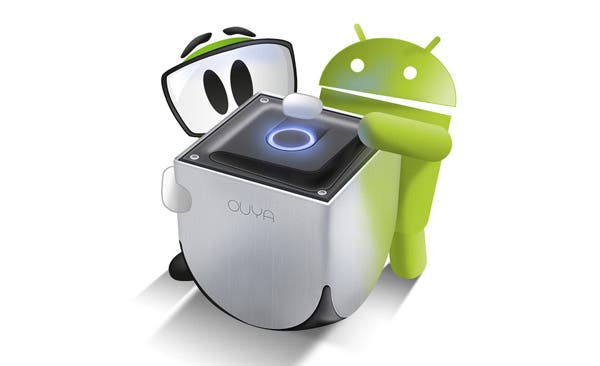
Just how capable Ouya actually is depends entirely on how the chip is deployed. The Ouya team is hinting heavily that the chip will be overclocked, but realistically we are looking at a 10-20 per cent max speed boost. A theoretical 2GHz Tegra 3 with 620MHz GeForce cores will obviously outperform the Nexus 7 and other mobile products based on the same chipset, but the DDR2 could well hold back performance as we see in our tests with the Transformer Prime.
Even if the Ouya processor exceeds expectations, it still represents a fraction of the power you'll find in a current-gen HD console and our gut feeling based on the benchmarks we've seen and the games we've played is that it would still lag some way behind the PowerVR tech in the latest iPads. In the Android arena, the new Snapdragon S4 is already employing next-gen ARM Cortex A15 cores and a really useful Adreno 320 GPU - in theory it should easily move beyond the A5X in terms of power, and blitz the Tegra 3.
This is our biggest concern with Ouya - by the time it launches, it could be left in No Man's Land in performance terms. NVIDIA will have moved on to its new Project Wayne technology (aka Tegra 4) and the chances are that Apple will have migrated onto the game-changing PowerVR Six Series Rogue GPU. According to NVIDIA roadmaps, Tegra 3 is twice as powerful as Tegra 2, but Wayne eclipses that with a 10x performance boost, while what little we know about Rogue suggests that, in terms of raw horsepower at least, it will be roughly on par with the Xenos chip inside the Xbox 360.
Both NVIDIA and IMG chips will also benefit from DX11 feature-sets too. These performance increases are possible for the same reason that sees Xbox 360 and PS3 replaced next year - the move to mass production on the smaller 28nm fabrication process. Ouya - a fixed platform using what will then be mid-range mobile tech - could well become outdated within a year of launch, such is the awe-inspiring pace of mobile graphics development right now.
But, on the flipside, the relatively low levels of power on offer may well play to the strengths of an indie-led platform where GPU power takes a backseat to the ingenuity of the coding community. Certainly, if Ouya gains momentum it can only mean good things for NVIDIA's future prospects: a larger catalogue of Tegra-enhanced titles that'll run even better on next-gen mobile hardware, plus a new generation of developers with experience in extracting the most performance from its existing technology. And while Ouya may well lack the raw horsepower compared to next year's mobile superstars, developers just love the advantages of developing to a fixed platform - not to mention the bonus attraction of easily porting to a multitude of other Android devices.
